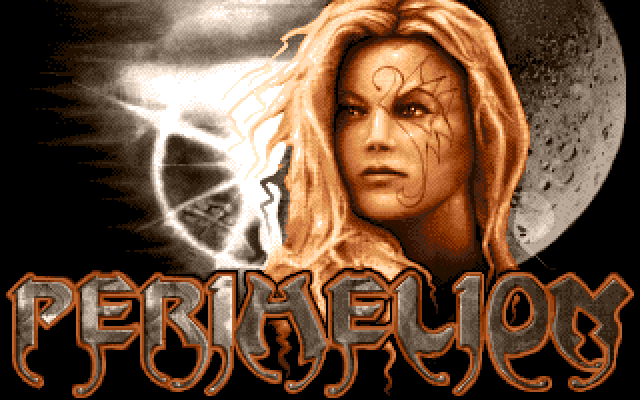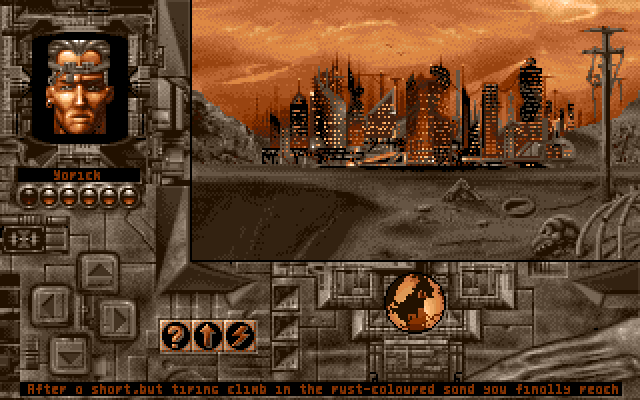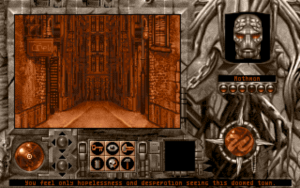Perihelion: The Prophecy 
If we’re going to talk about Perihelion: The Prophecy, we have to talk about the intro sequence.
Please watch this first.
In six minutes, the game lays bare an explosive, apocalyptic world of misery and chaos, a doom-metal premonition of the end of civilization, strewn with blood, sand, and fear. As the game blasts terrifying music and the screen fills with run-on sentences about the end of the universe, I actually found myself laughing from how extreme it was. It begins with a voice shouting a prophecy at you, and it never chills out.
The rest of Perihelion: The Prophecy lives in the aftershocks of that introduction. There is no way it could possibly live up to what it promises.
By necessity, the story has to settle down into something more manageable and predictable. In accordance with an ancient prophecy – there’s always an ancient prophecy, right? – six warriors have been awakened from a deep slumber to defeat the Unborn, an “unbelievably powerful superentity” whose arrival has plunged the world into chaos, spreading “horrible genetic distortions” and mysteriously, violently killing people far away. Frankly, it’s not clear what’s even worth redeeming about this terrible world. Considering that you’re following orders from the despotic sun emperor Rex Helion, it’s difficult to feel like you’re doing much good.
This desert wasteland once belonged to an advanced society, destroyed some unknown millennia ago in a nuclear war. Rex Helion rules over whatever remnants are left, a few scattered pockets of civilization that are still somehow keeping alive, miserable, but functional. Despite the epic, poetic manner in which the game describes this world – “a memento of the vanished past in this decaying, damned present” – it can be pretty boring. The desolation doesn’t offer much to do or see, even in a major city. Much like the introduction, the draw seems to be how the game presents the look and feel of this setting in the richest way possible.
Everything in Perihelion, including the interface, is beige or orange, rusted and covered in sand. Edvard Toth, one of three people at the appropriately named company Morbid Visions that created Perihelion, says on his personal website that he illustrated the entire game with a “32-color two-tone palette which in retrospect was a pretty bold move but it was a key element in providing a unique look and a very consistent atmosphere.” He’s dead-on; the contrasting dirt-and-metal color scheme is striking. The interface melds old battle-worn computers with semi-organic relief art of tendrils and veins merging into circuitry, and the game presents it in a single unsettling dull metal hue. Although the scenery blurs together after a while because of its nearly monochrome orange palette, the fucked-up future of Perihelion couldn’t look any other way except like this, trapped in a dusty, orange haze.
Even more than the dirty visuals, the audio adds texture that helps sell the idea of this decaying cyberpunk hellscape. This is unusual to say about a role-playing game, but Perihelion is a game led by its sound design. Old machinery hums and groans, wind howls through the desert, and every button makes a clicky electronic noise. Due to the level of audio compression used on the Amiga, the game has a scratchy sound quality to it, like many Amiga games, but scratchy electro-mechanical noises are exactly what this decrepit society would feel like.
Morbid Visions concocted an amazing worn-out psycho-theocratic apocalypse, and it can’t help but grab your attention. As you progress through far-off settlements, like the “tower-monastery” of the great Entity Lord Neon, the world turns stranger and supernatural, with underground cultists and psychic possession. A sense of biblical doom festers beneath, creeping out from the ruins of the old-world technology.
There are so many idiosyncratic features and systems built into Perihelion, like a bizarre magical rune system that Toth says was designed as an anti-piracy measure that requires the manual to understand, or a dystopian version of the internet that you use through an intentionally user-hostile command-line interface, or a character rating for their ability to resist “extreme sound.” Seeing them for the first time raises exciting questions about what this game will be like. But as keeps happening in this game, the reality can never live up to the promise.
In execution, the actual role-playing game part of Perihelion tends to be flat, cluttered, and unapproachable. Long stretches of the game are set in desolate featureless mazes, and the battles move at a rhythm that feels like a gamemaster double-checking their rulebook, refreshing themselves on the formula for how quickly characters bleed out after they’ve been shot, bound by layers of mechanics that prevent the fight scenes from flowing more easily. Playing it today is a chore, like filling out a worksheet. Nothing about it is bad, necessarily, just busy without being interesting.
I’ll admit that role-playing games aren’t the genre I’m the most comfortable with, and I may have missed out on the strengths of those sections. This isn’t a particularly difficult or complicated RPG, though, and that makes me question whether this type of thick computer role-playing game that used to be the norm may simply be impenetrable 30 years later.
Is it only disappointing because Perihelion is otherwise so outrageous? It keeps coming back to that intro sequence, the high-gear apocalyptic hell that the rest of the game has to scramble to live up to.




I think this game and aesthetic perfectly encapsulates the 90s edginess and Euro flavour of the Amiga gaming scene. You had quirky UK games like Lemmings, weird French action-adventure games like Kult where the main difficulty was navigating the darn interface and piecing the lore from the obtuse dialogue…I always loved the off the wall games created in the early 90s: back then there was so much experimentation and companies had the balls of publishing weird stuff. Once gaming went mainstream in the early 00s, US and Japanese videogaming companies ruled the roost. Gaming is now bigger than movies and behemots churn out games as a service like there’s no tomorrow.
When I first played Perihelion in 1993, I was ten years old. The game was so scary, especially the sounds / ambience, that I turned it off pretty quickly I was too scared to try it again.